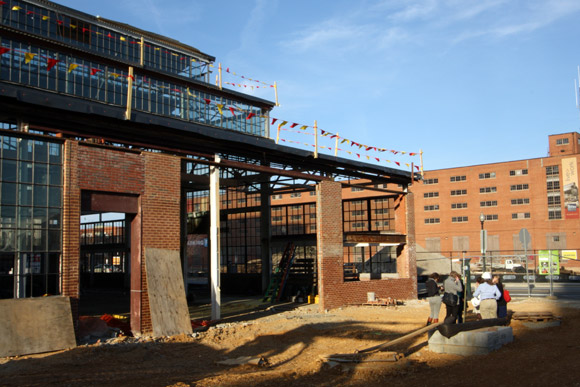Restaurants are notoriously risky business ventures, even then they are situated along a corridor with everything in place for success: lots of foot traffic, a central location, proximity to other restaurants, a recognized address. Breaking ground in an area not known for its food scene takes the stakes up another level.
Yet with real estate in DC’s central business districts going for a premium and many popular areas approaching saturation, savvy restaurateurs are taking chances on emerging neighborhoods, hoping that residents’ (and visitors’) ceaseless appetite for the next food destination draws them to parts of the city they might not have considered visiting.
“Pioneers will go through some struggles that those that go into more high-traffic places won’t have,” says DC restaurateur Michael Babin, “but there are some rewards. The people who live in that neighborhood and are also invested in it appreciate that you’ve taken a chance in their community.”
�We wanted to be a part of the turnaround that was going on there.�
Babin is himself a “seasoned pioneer” in the local restaurant scene. He opened his first restaurant,
Evening Star Café, in his own neighborhood of Del Ray in 1997, back when the area had a much rougher image than it does today. “We were dealing with public drinking on the sidewalk in front of the restaurant, drug deals going down at closing time,” he says. “We wanted to be a part of the turnaround that was going on there.”
Since then, Babin and his
Neighborhood Restaurant Group have opened roughly a dozen food and drink-focused ventures in the DC and NoVA area, more if you count the second and third locations of some of them. When scoping locations for a new project, Babin and his group look for a strong local residential community, potential for traffic at various times of day, and neighborhoods and buildings “with character.” They’re currently working on the reopening of the Iron Gate Inn—DC’s oldest continuously operating restaurant until its shuttering in 2010--in the Dupont Circle area. In addition, they’ll soon be opening a few new venues in Capitol Riverfront.
That’s also the neighborhood where Stephen and Amanda Briggs, owners of
Zest Bistro in Capitol Hill, are planning their latest venture. Agua 301 will serve modern Mexican cuisine in a sleek space with a patio overlooking the water.
For the couple, a personal connection to the neighborhood was also a major factor in deciding where to set up shop. They live on the Hill and have been visiting Capitol Riverfront since Stephen’s stepfather bought one of the first condos there eight years ago.
Briggs also pointed to
Nationals Park, the baseball stadium, as a source of optimism for attracting crowds of both locals and visitors. Babin agrees: “Psychological geography is a lot different from actual geography,” Babin says. “I hope the ballpark helps break that barrier for a lot of people.”

Still, the risks of going into an area as a test case are real. “We know that going in as early as we are is the biggest risk we have,” says Briggs. “We’re independent and don’t have the cred of a lot of these other restaurant groups coming in. We really wanted to get in over there so we didn’t have the luxury of holding off—we had to move ahead.” As the area gains popularity, prices will inevitably rise, locking those without a lot of start-up capital out of the market.
He is glad to see the Capitol Riverfront area developing as a waterfront destination for DC. “We’re so connected to the water by history and yet you don’t see that in the city right now at all,” he says. The name of the new restaurant reflects that connection.
Briggs plans to capitalize on cross-marketing between their two restaurants to entice regular customers to try out the new concept, which he hopes will open in July.
Babin’s nearby
Bluejacket Brewery is arguably his most ambitious project yet. The 7,300-square-foot brewery and restaurant will produce an unusually wide variety of craft beers, requiring custom-built equipment and Old World fermentation techniques that optimize for flavor rather than quick revenue-generating potential.
Stories like that of
Union Market in NoMa serve as a source of inspiration for high-end restaurateurs moving into emerging neighborhoods. The indoor market, which intersperses permanent vendors selling locally produced meats, seafood, cheeses, produce, and prepared foods with casual sit-down dining space and the occasional pop-up, is a project of retail development company
Edens. It opened in September 2012 on the site of the 1931 Union Terminal Market, which fell into decline in the 1980s as the aging space and urban decay around it pushed many of its wholesale merchants elsewhere.

The location lacked the proximity to residential and retail hubs that restaurants tend to rely on to bring in traffic, but Edens and the project’s culinary director, chef Richie Brandenberg, believed it had the potential to attract crowds.
To get the word out about the market, Brandenberg employs what he calls “guerilla marketing,” sending staff from various vendors to hand out samples at the NoMa metro station a few blocks away: Peregrine coffee, bread from
Lyon Bakery with
Trickling Springs Creamery butter.
So far, he’s been thrilled with the turnout. “We’re definitely busier than we anticipated and sales are constantly growing,” he says. “Several vendors are asking for more space, which is almost completely sold out.”